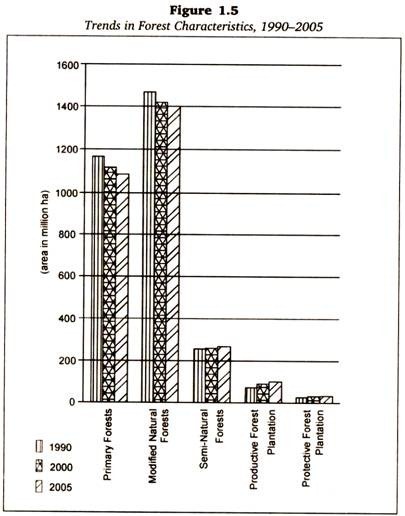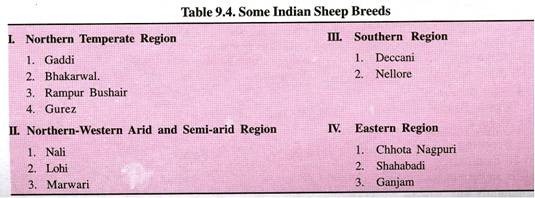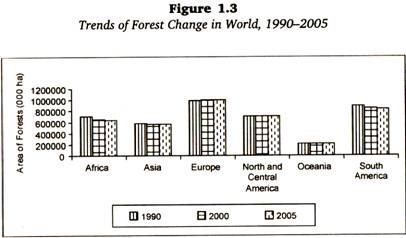Forests show a decreasing trend during 1990-2005 but the rate of forest loss is slowing down.
Deforestation, primarily for agricultural land, and urban expansion continues at an alarmingly higher rate during the said period.
At the same time, plantation forests, restoration and natural expansion of forests have significantly reduced the total forest loss.
About 31.20 per cent of total land of world was under forests in the year 1990, which marginally decreased to 30.50 per cent in the year 2000 and further to 30.30 per cent in 2005.
Total net change of forests during the period 2000-2005 is estimated at -7.3 million hectares per year, which was about -8.9 million hectares per year in the period 1990-2000. Thus, it can be said that rate of forest loss has slowed down.
Total net loss for countries with a negative change in forest area was 13.1 million hectares per year during 1990-2000 and 12.9 million hectares per year during 2000-2005. This indicates that annual deforestation rates for world as a whole are slowly decreasing. Similar trend of deforestation has been noted in Africa, North and Central America, South America and Oceania. While Asia recorded loss of forests during 1990-2000 and marginal increase in forests during 2000-2005 (FAO, 2005).
Only Europe shows positive trends of forests in all years, i.e., 1990-2005 (Table 1.2). However, the rate of increase in forests slowed down in 2000-2005 (Figure 1.3).
Africa recorded maximum forest loss as about 4.3 million hectares each year during 1990-2000, which declined to about 4 million hectares each year during 2000-05. Thus, rate of deforestation is slowly declining in Africa. While South America, which lost about 3.8 million hectares of forests in 1990-2000, witnessed maximum loss of about 4.3 million of forests in 2000-2005.
It is, thus, concluded that rate and net loss of forests has increased in the recent years over South America. North and Central America and Oceania lost about 0.35 million hectares and 0.5 million hectares of forests respectively during 1990-2000. Forests of these regions have remained almost unchanged during 2000-2005, as North America recorded marginal increase and Oceania marginal decrease in deforestation.
Forest areas in Europe continued to expand in 2000-2005, although at a slower rate than in the 1990-2000. Asia witnessed significant positive changes in forest cover. It recorded loss of about 0.8 million hectares per year in 1990-2000 and a gain of 1 million hectares per year during 2000-2005, primarily as a result of large-scale afforestation in China and India (Figure 1.4). Detailed analysis of forest characteristics viz., primary forests, modified natural forests, semi-natural forests and protective and productive forests reveals that primary forests and modified natural forests are declining but the rate of decline is slowing down. Primary forests recorded the loss of about 60 million hectares in 1990-2000 and about 25 million hectares during 2000-2005.
Detailed analysis of forest characteristics viz., primary forests, modified natural forests, semi-natural forests and protective and productive forests reveals that primary forests and modified natural forests are declining but the rate of decline is slowing down. Primary forests recorded the loss of about 60 million hectares in 1990-2000 and about 25 million hectares during 2000-2005.
This decrease was caused by deforestation, selective logging and other human interventions, thus primary forests turn into the modified natural forests. Similarly, modified natural forests witnessed the loss of about 55 million hectares in 1990-2000 and about 10-12 million hectares during 2000-2005. Few European and Asian countries experienced marginal increase in primary forests. Semi-natural forests and plantations are continuously increasing.
The area of forests plantations has increased by about 2.8 million hectares per year during 2000-2005, 87 per cent of which are productive forest plantations. FAO (2005) generalized that primary forests and modified natural forests are decreasing, while the areas of semi-natural forests and plantation forests are increasing (Figure 1.5). Degradation of natural forests, particularly due to selective lopping and plantation of non-native species, has made many native species endangered throughout the world (Table 1.3). A large number of tree species are critically endangered, endangered and vulnerable.
Degradation of natural forests, particularly due to selective lopping and plantation of non-native species, has made many native species endangered throughout the world (Table 1.3). A large number of tree species are critically endangered, endangered and vulnerable.
As far as critically endangered and endangered species are concerned, Asia, South America and North and Central America are at high risk, whereas Oceania and Africa are at low risk. Europe has showed significant improvement in sector of forestry in the last 50 years.
Europe is at a least risk with regard to any kind of threat to tree species. With regard to vulnerable tree species, except Europe and Oceania, all the other regions are facing high degree of threat. Overall, it can be said that North and Central America, Africa, South America and Asia are particularly at high risk (Table 1.3). As per the analysis of world’s forests during 1990-2005, Asia occupies a unique position (Figure 1.4). Asia is the only region in the world, which not only minimized its forest loss but also made remarkable improvement in forest cover. India and China have particularly shown significant improvement in forest cover.
As per the analysis of world’s forests during 1990-2005, Asia occupies a unique position (Figure 1.4). Asia is the only region in the world, which not only minimized its forest loss but also made remarkable improvement in forest cover. India and China have particularly shown significant improvement in forest cover.
